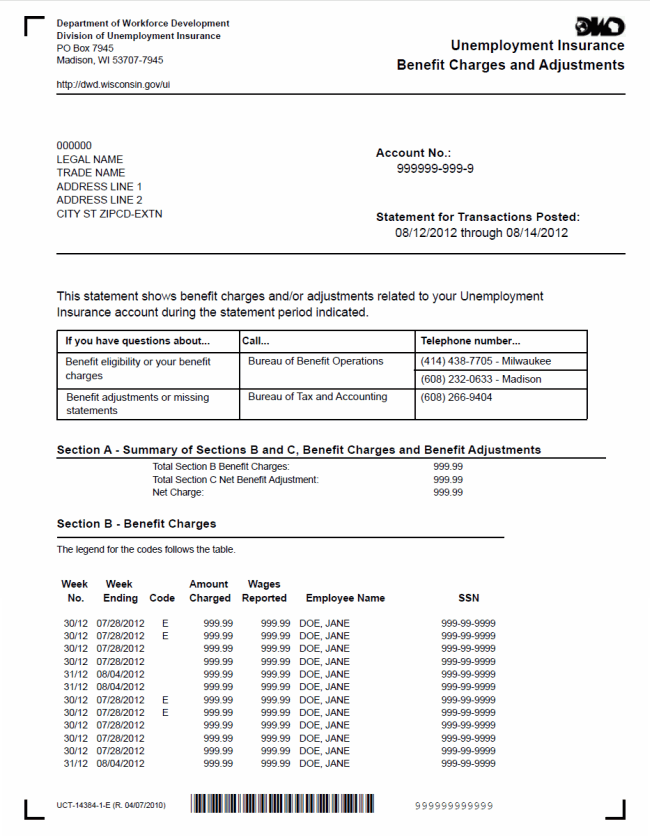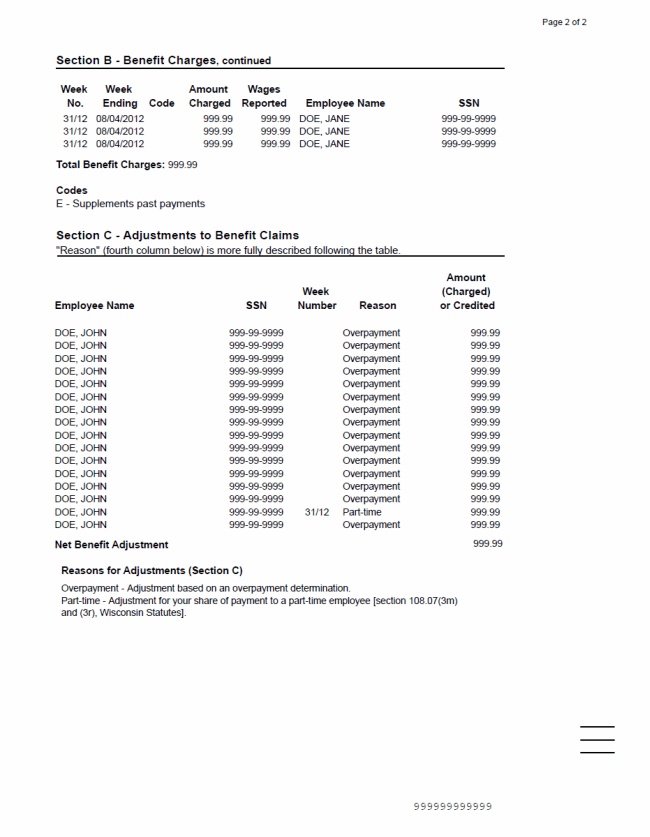Form Summary
- Account No:
- This is the reimbursable employer UI account that all benefit charges
and adjustments were debited or credited during the period.
- Statement for Transactions Posted:
- This is the time period that the activity in your account covers.
- Section A – Summary of Sections B and C,
Benefit Charges and Benefit Adjustments
- Total Section B Benefit Charges: This represents the total of all
benefits charged to your account during the time period specified above for
the individuals and amounts listed in Section B below.
- Total Section C Net Benefit Adjustment: This represents the net of
the amounts debited and/or credited to your account during the time period
specified above for the individual benefit adjustments listed in
Section C below.
- Net Charge (Credit): This is the total of Section B benefit
charges plus or minus the total of Section C net benefit adjustment.
This amount represents the net charge or credit to the account for the time
period indicated above.
- Section B – Benefit Charges
- This section lists all benefits charged to your account and may include
payments made to more than one claimant. Individual claimants are
listed separately
- Week No.: The actual calendar week for which payments have been
made. Payments for more than one week for a claimant may have been
made during the report period. Each week is listed separately. A
claimant’s payment for a given week may have a number of deductions for
various reasons such as federal and state withholding, child support, and
benefits withheld to repay a prior overpayment of benefits. Each
distribution is listed separately on the report but the total of the
distributions for a given week should never exceed your weekly liability for
the claim.
- Week ending: The last day of the indicated Week No.
- Code: This code references an explanation of the charge listed in
the legend that follows the table of benefit charges.
- Amount Charges: This is the amount of benefits charged to your
account for the indicated week and employee listed.
- Wages Reported: These are the wages earned by the employee from
all employers in the week listed. The claimant may or may not have
earned any wages from you in the week listed.
- Employee Name: Last and first name of the employee whose benefits
have been charged to your account for the week listed.
- SSN: Social security number for the employee listed.
- Section C – Adjustments to Benefit Claims
- This section lists all adjusting benefit entries make to your account
including both credits and charges. Any action taken on a benefit
claim that changes the employer’s liability for a particular payment will
result in an adjustment to an employer’s account and will be listed in this
section. Some examples include:
- Amendments made to a claim that affect the proration of
liability charges to employers in the claim (even charges that are
unrelated to the claimant’s work and wages from a given employer can
affect the employer’s prorated share of the liability charges).
- Repayments made by a claimant whose benefits were previously charged
to your account but were subsequently determined to be overpaid.
- Section C can also include quarterly charges from other states.
These charges represent the employer’s share of liability for claims
filed in other states which combined wages from more than one state to
establish the claimant’s benefit eligibility.
- Employee Name: Last and first name of the employee whose
benefits have been adjusted and either charged or credited to your account.
- SSN: Social Security number for the employee listed.
- Week Number: The calendar week for which the original
payment that is being adjusted had been made. In many cases there is
no specific week listed.
- Reason: The reason for the adjustment which is described
more fully following the table of adjustments.
- Amount Charged or (Credited): This is the amount that has
been charged or credited to your account as a result of the adjustment.
Claimants Who are Still Working for You
If a claimant works for you in any week for which (s)he is paid unemployment
benefits, you will initially be charged for your share of the payment in Section
B. However, if the employee earned gross wages during that week which are
equal to or greater than the average weekly wage paid to the claimant in the
same calendar quarter of the previous year, your account will automatically
receive a credit for the charge in Section C. The credit may or may not
appear on the same report as the charge. Please see “Situations When
Liable Employers are Relieved of Charges” in “Part 4 – Calculating your
Liability for a Benefit Claim” of the Benefits Section for more detail on how
the average weekly wage amount is determined.
Claimants Who Have Quit
Reimbursable employers are usually charged for benefits paid to claimants who
have quit if the wages from the reimbursable employer are in the claimant’s base
period.




